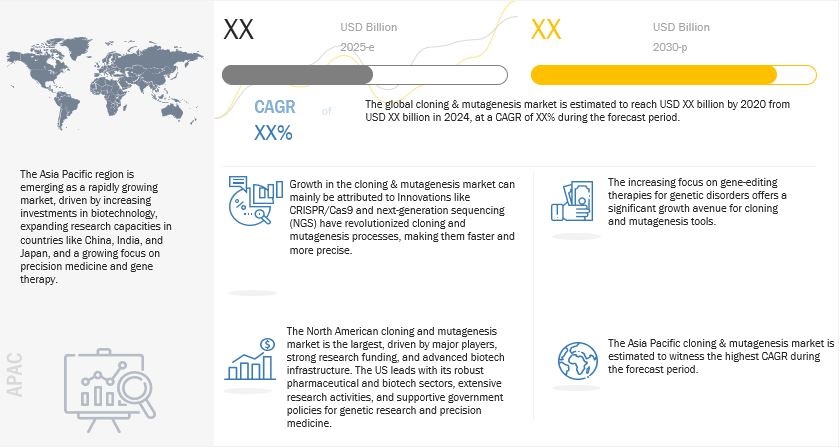Cloning and Mutagenesis Market - Global Forecast 2030
Cloning and mutagenesis are molecular biology techniques used to manipulate DNA for research, therapeutic, or industrial applications. The cloning and mutagenesis market is mainly driven by factors such as growing advancements in genomic technologies, increasing focus on personalized approach to therapeutics and increasing prevalence of genetic diseases. However, complexity of the techniques employed for cloning and mutagenesis along with few ethical concers are expected to pose challenges to the market growth.
Cloning and mutagenesis market- global forecast to 2030
Global Cloning and Mutagenesis Market Dynamics
DRIVER: Growing advancements in genomic technologies
Advancements in genomic technologies have transformed the field of cloning and mutagenesis, making it a powerful driver for the market. Modern genomic tools have significantly improved the precision and efficiency of cloning and mutagenesis processes. Technologies like DNA printing enable the creation of synthetic genes without requiring a template. This reduces the dependency on natural DNA samples and accelerates cloning workflows. Moreover, Genomic advancements have brought automation and scalability to cloning and mutagenesis. NGS allows rapid verification of cloning and mutagenesis results, ensuring higher accuracy in applications like gene therapy and diagnostics.
RESTRAINT: Complexity of techniques
The complexity of techniques in cloning and mutagenesis acts as a significant restraint to market growth, particularly for smaller organizations or less-experienced users. Many cloning and mutagenesis techniques are intricate and require advanced skills and training. Processes like PCR, restriction digestion, ligation, and transformation demand a deep understanding of molecular biology and biochemistry in case of cloning. Even small errors, such as incorrect primer design or poor reaction conditions, can lead to failed experiments. Mutagenesis requires precision in designing primers and understanding the gene of interest. Achieving site-specific changes without introducing off-target effects can be technically challenging.
Recent Developments:
- In May 2022, Qiagen acquired BLIRT, QIAGEN N.V. announced the acquisition of a 96% majority ownership stake in BLIRT S.A., a Gdansk, Poland-based manufacturer of recombinant enzymes for the life science industry. This strategic move aims to enhance QIAGEN's capabilities in enzyme development and production, thereby strengthening its sample technologies and expanding its global presence. The integration of BLIRT's specialized enzyme portfolio is expected to create additional growth opportunities for QIAGEN's existing offerings.
- In February 2022, Tamara Bio, Inc., a central hub for cell and general processing in Japan, announced the expansion of its production facilities. The newly established laboratory will focus on manufacturing products such as cancer immunotherapy drugs, gene therapies, DNA and RNA vaccines, and leveraging cloning and mutagenesis techniques for regenerative medicine applications.
To speak to our analyst for a discussion on the above findings, click Speak to Analyst

















Growth opportunities and latent adjacency in Cloning and Mutagenesis Market